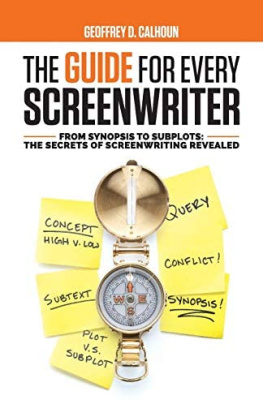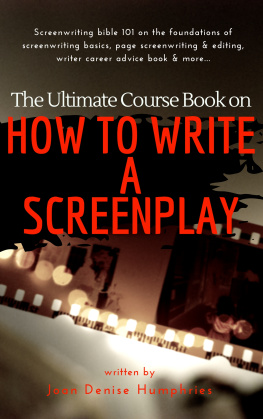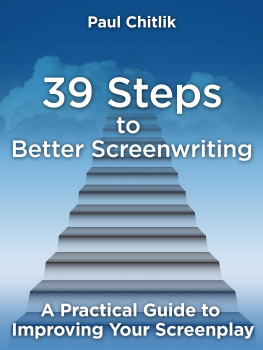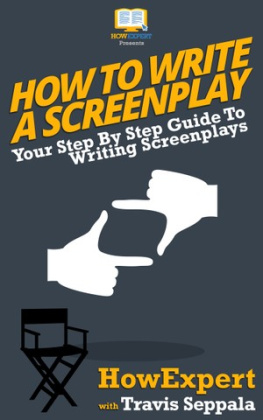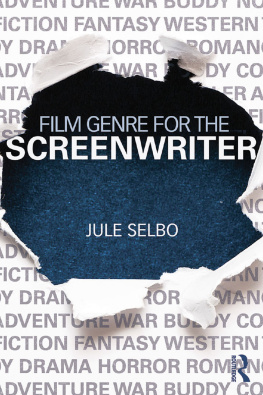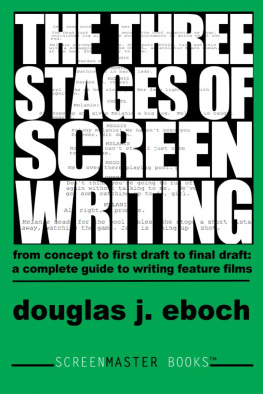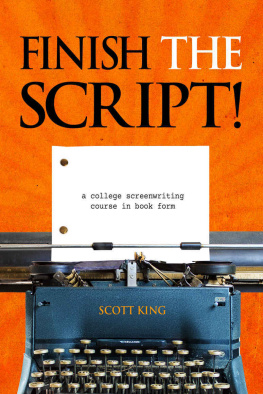THE GUIDE FOR EVERY SCREENWRITER From Synopsis to Subplots: The Secrets of Screenwriting Revealed
By Geoffrey D. Calhoun
Copyright 2019 by We Fix Your Script - All rights reserved. It is not legal to reproduce, duplicate, or transmit any part of this document in either electronic means or printed format. Recording of this publication is strictly prohibited. ISBN: 978-1-7339896-1-9
Editor: Jayne SouthernCover photo and design: Adam Flor
I read The Guide for Every Screenwriter in one sitting.
Geoffrey D. Calhouns book provides insight any storyteller, not just screenwriter, can use. The guide had me thinking about my script and inspired me to write within the first ten pages.
What makes this book elemental for a writer is the specific simple framing of an extraordinarily complex process. Everyone has bits of their movie in their head for those of us still learning the craft, its easy to let a story overwhelm us and lead to failure. Geoffreys book reaches down and provides accomplishable steps to not only get past the pitfalls, but also profoundly improve a great idea into a wonderful one.
- Pete A. Turner, Host of the Break It Down Show
This is the book I wish Id read ten years ago! A no non-sense, straightforward, and vital easy to follow guide for screenwriters both new and experienced. This is my new go-to guide for all things screenwriting. You better believe itll be close by from now on.
- Cat Connor, Author of the Byte Series
There are so many books on screenwriting. Although many of them offer tips on structure, and development, few books deliver the information into something di-gestible for aspiring writers. Most books can leave people feeling more confused than when they started.
The Guide for Every Screenwriter is one of the most efficient instruction manuals on the craft.
Geoffrey D. Calhoun cuts past the verbose film school expository, and gets straight to work, delivering a sample-driven checklist that anyone can follow. Whats remarkable about this book is how quick it is to apply to your work. It serves as a side-by-side checklist for the writing process.
I recommend this book to anyone looking to write a
screenplay, and to any professional needing a refresher.
- Kelly Schwarze, Director - Indie Film Factory
Foreword
Like Strunk and Whites Elements of Style, this book aims to give the reader and the writer a map to guide them. It takes the writers hand and assists them with proper fundamentals and structure. I like this book. I like what it does if you use it properly. This miniature tome gives you the keys to the kingdom.
Ive been involved with writing for over four decades. I have run over 30 Written Word Competitions over the last twenty years, read thousands of scripts, written over
300 episodes of Network Television and produced 5 films
from my own screenplays (including the script for Behind
The Gate with Academy Award Winner Joe Pesci). In short, Ive seen it all. You could read one hundred books on screenwriting and still never get a tenth of the pure truth for the scribe that comes from cracking these pages open and then cracking open your mind to accept the truth of structure, process, intuition, and skill.
With this brilliant book, Calhoun has not only drawn a line, but he has also made a bulwark of design in language, style, and instruction that anyone can follow. The question is, Will they? I really hope they do because there are a million ways to go wrong but only a few ways to get it right. Getting it right begins with structure. Screenwriting is one of the most difficult and rewarding
crafts of all the crafts that have ever existed in the world.
Think of all the trades and skills that have died over the last two thousand years. Now consider the fact that writers have outlasted them all. Why? Because the true hero-ics of a story is the ability to properly format, design, cre-ate, and launch your story successfully out into the universe.
-Del Weston
This book is dedicated to: My Muse, My Heart, and My Soul. To my wife, my son, & my mother. This ones for you.
We are like dwarfs sitting on the shoulders of giants. We see more, and things that are more distant than they did, not because our sight is superior or because we are taller than they, but because they raise us up, and by their great stature add to ours.
-John Salisbury, 12th-century theologian
Introduction
Thank you for checking out this book! Inside we cover all aspects of screenwriting from concept to completion and what comes next. All with practical and easy to follow outlines, templates, tips, and tricks developed by a professional screenwriter.
As an autodidact, I first began my screenwriting career by tearing through books, seminars, classes, you name it. I had and still have an insatiable thirst to master this craft. Id pester mentors until they unwillingly gave up their deepest secrets. Having done that, I was frustrated there wasnt a one-stop shop for screenwriting. | have an extensive library filled with books on the subject. Thus, Ive decided to con-dense all of the knowledge Ive gained over my ten plus years into a small, easy-to-carry guide that you can refer to whenever you need it. I will also cite several masters of the craft and their work; thus you will be
able to expand your own knowledge even further.
With this book, Ive compiled my slides and seminars about screenwriting into easy visuals for you to access. We will cover topics from character development, format, structure, the secrets to subplots, building your career, and everything in-between.
*Please note this book is not here to discuss Aristotle, the Greek mythologies, or story structures which others have discussed prior to this work. This book refers to the modern age of screenwriting and uses popular films as examples for reference material.
I will also make you a promise. This text will not be hyperbolic and long-winded. As a screenwriter, my job is to be spartan with my writing. To use as few words as possible and make them powerful. I will not sell you fluff to impress you with my vast knowledge. I am a working writer who has clawed his way to success over a decade of struggles. Thats it. Hopefully, it will help you along your path as well. Now, let us begin.
PART I: DEVELOPMENT
What is Screenwriting?
Screenwriting: a visual medium conveyed through the written form. That sounds lovely and sophisticated but what does it mean? Robert Mckee in his manuscript Stery coined the phrase Show, dont tell. Thats it in a nutshell. We show the characters journey through action and conflict.To truly understand what screenwriting is, its best to compare it with other forms of entertainment.
Novel:
Prose plays out through a characters thoughts. Conflict is driven through their internal struggles. When you read a book, you are in a characters head and see the world through his or her eyes.
Stage Play:
This is vocal. Yes, it is on stage and we see the actors, a set, and props,
but we hear a characters conflict through dialogue. Plays are all about the spoken word. Conflict is expressed verbally.
Side note: Screenwriters like David Mamet and Aaron Sorkin are praised and hailed for their outstanding dialogue in scenes. Thats because both of them were established stage writers before they shifted into screenwriting.
The Proof? Danny Boyles Steve Jobs written by Aaron Sorkin, is a fan-tastic biopic feature film which has an 6% on Rotten Tomatoes, a trusted measurement of quality for Movies & TV.2 That film is structured as a stage play, with only a few locations used repeatedly. Dialogue drives conflict the entire time. 3
Screenwriting: This is visual. We see our characters conflict play out on screen. The best films express conflict visually and avoid the talking heads trap,
Next page
